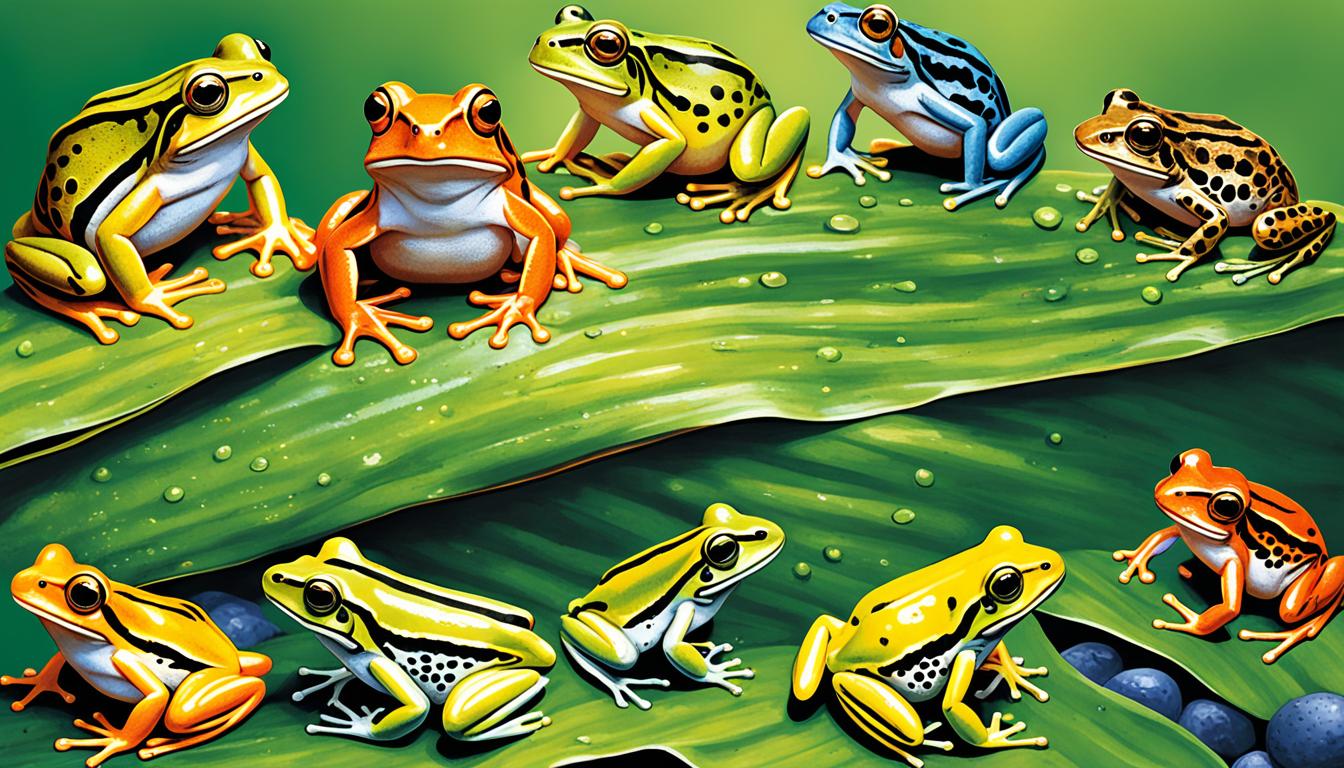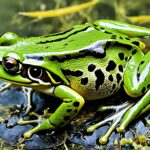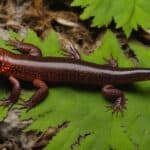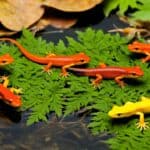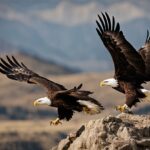Figuring out the species of frogs in the USA is an exciting journey. Look closely at their physical traits and get advice from experts to tell them apart. This guide blends how to ID American frogs with community science. It helps you join the effort to save these cool creatures.
Start by noticing their size, color, and special markings. Understand where they live and listen to their calls. Use field guides and websites to get better at spotting them. This way, you help preserve the variety of frogs across the USA.
Introduction to Frog Identification
Frog identification is both exciting and rewarding. With a frog species identification guide, you can discover various American frogs in your backyard. This journey also helps in conserving these important species.
Identifying American frogs involves looking at their behavior, looks, and where they live. By using a frog species recognition guide, you help in preserving the ecosystem. This makes you part of an important conservation effort.
Many people enjoy finding and identifying different frog species. Noticing unique features and learning about new species is very educational. It also shows us the varied roles these animals play in nature.
“Frogs are disappearing around the world; however, through dedicated and passionate efforts, we can conserve these incredible species.” – Dr. Kerry Kriger, Founder of SAVE THE FROGS!
By identifying frog species, you can help protect them and their homes. A frog species identification guide is a powerful tool in this mission. Join others who love nature and work together to protect our planet’s varied life.
Key Physical Characteristics of USA Frogs
Learning the main traits of different frogs helps to spot various species in the USA. We will look at the key physical features. These will help in telling one frog species from another.
Size and Shape
Frog size and shape tell us a lot about them. For example, the tiny Spring Peeper contrasts with the big American Bullfrog that can be over six inches. Other features like head width, leg length, and body size are also important for identification.
Color Patterns
The colors and patterns on a frog are unique to each species. Some, like the Green Treefrog, are one color. But the Northern Leopard Frog has dark spots on a green or brown skin.
Unique Physical Traits
Some frogs have special features that stand out. This includes webbed toes, glands near the eyes, and unique skin. The Grey Treefrog can change color while the Wood Frog has a dark mask over its eyes.
Detailed comparison of physical traits can be found below:
| Trait | Example Frog Species | Distinctive Features |
|---|---|---|
| Size and Shape | American Bullfrog | Large, robust body, over six inches long |
| Color Patterns | Northern Leopard Frog | Dark, rounded spots on a green or brown background |
| Unique Physical Traits | Wood Frog | Dark mask-like marking across eyes |
By really looking at these frog traits, you can correctly spot and name the frogs in the USA.
Exploring Frog Habitats in the USA
First, we need to look at where frogs live to know more about the different kinds. Each place gives us clues about which frog we might see. Now, we’ll check out the usual spots where frogs are found.
Wetlands: Plenty of frog types love wetlands because of the water and plants. These places are marshes, swamps, and floodplains. You’ll see frogs like the American Bullfrog and the Northern Leopard Frog here a lot.
Woodlands: Areas with lots of trees and moisture are perfect for frogs. The Gray Treefrog and the Spring Peeper live in these parts. The trees and moisture offer them good places to hide and make babies.
Grasslands: Though less common, grasslands are important for some frog kinds. The Great Plains Toad, for instance, prefers prairies and meadows.
Here’s a look at different frog living spaces and who you might meet there:
| Habitat | Characteristics | Common Frog Species |
|---|---|---|
| Wetlands | Abundant water, lush vegetation | American Bullfrog, Northern Leopard Frog |
| Woodlands | Dense tree cover, moist environment | Gray Treefrog, Spring Peeper |
| Grasslands | Open meadows, prairies | Great Plains Toad |
Knowing about these frog spots helps people who love frogs and scientists. They can figure out which frog is which. The special things about each place help us choose from the many kinds of frogs.
“Knowing where frogs live is key to telling them apart. This helps us explore the wide variety of frogs in the USA.” – Dr. John Keating, Herpetologist
By learning more about these places, you get better at spotting different frogs. This adds to what you know and helps protect these animals.
Geographical Location as an Identifier
Knowing the geographical location in frog identification helps a lot. It greatly reduces the number of species you might find. Each part of the United States has its own kinds of frogs. This makes where you are a key hint.
Some frog types live only in certain areas. Take the California Red-Legged Frog for example. This frog can only be found on the coast of California. On the other hand, the American Bullfrog once lived in the east. Now, it’s all over the country.
| Frog Species | Geographical Location | Key Characteristics |
|---|---|---|
| California Red-Legged Frog | California Coast | Reddish coloring on legs, large size |
| American Bullfrog | Eastern USA (now widespread) | Large size, greenish-brown color |
| Wood Frog | Northeastern USA | Dark mask-like marking across its eyes |
| Chiricahua Leopard Frog | Southwestern USA | Green with black spots, webbed feet |
Looking at where frogs live is key in identifying them. It tells us a lot about their kinds and numbers. It also helps keep them safe.
Recognizing Frog Calls for Species Identification
Frog calls are like unique fingerprints for each species. They are key in identifying frogs accurately. This makes knowing frog calls important for telling species apart.
Listening Techniques
To spot frog species by their calls, you must use the right techniques. Find a quiet spot near water. Frogs like to stay there. Also, it’s wise to have a recorder to save the sounds.
Make sure you check the time of year and the weather. Frog calls change with the seasons and weather. This can help in knowing what frog you’re hearing.
Common Frog Calls in the USA
In the USA, there are many frog species, each with its own call. Here are a few you might hear:
| Frog Species | Call Description | Habitat |
|---|---|---|
| American Bullfrog | Deep, resonating “jug-o-rum” sound | Ponds, lakes, and slow-moving streams |
| Spring Peeper | High-pitched “peep” noise | Woodlands and wetlands |
| Green Treefrog | Quacking sound similar to a duck | Swamps, marshes, and wet forests |
| Wood Frog | Soft, clucking noise | Forested areas near shallow water |
By learning these listening methods and the common frog calls in the USA, you can get good at recognizing them. This uses the frog calls identification guide for getting species right.
How to Identify Different Species of Frogs in the USA?
To tell frog species apart in the United States, you need to carefully observe and listen. Look at their size, body shape, and colors. Notice special features like webbed toes or unique skin glands too.

Frogs live in different homes, like wetlands or forests. Knowing where they live helps with identification. Certain frogs are found only in specific places.
Listening to frog calls is also key. Each species has a different sound. By practicing hearing these calls, you can get very good at picking out the different frogs.
Here are the steps for a detailed frog species identification process:
- Observe the frog’s size, shape, and color closely.
- Take note of special features like webbed feet.
- Pinpoint the area they were in, their habitat.
- Think about the region where the frog was found.
- Compare their calls to known recordings.
By carefully going through these steps, you will succeed in identifying frog species in the USA. This method not only helps you learn but also supports conservation and research efforts on these amazing creatures.
Using Field Guides and Online Resources
Starting the quest to spot different frog types in the USA is simpler when you use field guides for frog identification and check out what online resources offer for recognizing frogs. Many beneficial books and websites are there. They help you find frogs more easily.
Recommended Field Guides
Field guides are a top pick for fans and experts. Check out these top choices:
- A Field Guide to Reptiles and Amphibians by Roger Conant and Joseph T. Collins – It’s a thorough guide on many American frog types.
- Peterson Field Guide to Reptiles and Amphibians of Eastern and Central North America by Robert Powell, Roger Conant, and Joseph T. Collins – Praiseworthy for its detailed info and beautiful pictures.
- Amphibians and Reptiles of the Midwest by Jeffrey E. Davis and Gary K. Pauley – It gives special insights into Midwest species.
Top Online Resources
Using online resources to identify frogs opens doors to the latest info and handy tools. Below are some great places to look online:
| Resource | Description |
|---|---|
| AmphibiaWeb | An extensive database offering detailed species accounts, distribution maps, and even frog call recordings. |
| HerpMapper | A citizen science initiative that collects data on amphibian and reptile sightings worldwide, aiding in identification efforts. |
| iNaturalist | A popular platform where you can share your sightings and get help identifying them from a group of specialists. |
| FrogWatch USA | An online initiative that connects frog fans, lets them track frog numbers, and supports in spotting various species. |
By using field guides for frog identification and diving into online resources for recognizing frogs, you can improve your frog species ID skills in the USA. These tools give you thorough details and fresh data, making learning about frogs fun and engaging.
Consulting Experts for Frog Species Identification
Figuring out different types of frogs can be hard. Sometimes, you need to talk to experts to get it right. Herpetologists and avid frog fans are great for tough cases. SAVE THE FROGS! and similar groups can connect you with people who know their stuff.
“Accurate identification of frog species not only satisfies personal curiosity but also contributes to critical research and conservation efforts,” notes Dr. Kerry Kriger, the founder of SAVE THE FROGS!
- Online Forums: Look for places online where frog lovers hang out. They often have sections for experts to help with IDs.
- Local Universities: Universities often have experts in their biology departments. They’re usually willing to help identify your frog.
- Environmental Organizations: Getting involved with groups like the American Society of Ichthyologists and Herpetologists (ASIH) can help. You’ll meet frog experts through these networks.
Getting help from herpetologists makes sure your frog data is right. This is key for citizen science projects to be reliable. When you work with experts for frog IDs, it helps you and furthers frog conservation.
| Resource | Type | Contact Method |
|---|---|---|
| Online Forums | Interactive Platforms | Message Boards, Direct Messages |
| Local Universities | Academic Institutions | Email, Office Visits |
| Environmental Organizations | Non-Profit Groups | Membership Portals, Networking Events |
Case Studies: Common Frogs in the USA
Studying common frogs in the USA helps us learn how to identify them. By looking at different American frog types, we get to know what makes each one special. This helps us tell them apart when we see them out in nature.
The American Bullfrog is a well-known type (Lithobates catesbeianus). It’s big with green skin and dark spots. You’ll hear its deep, loud “jug-o-rum” sound near water. Knowing these details makes spotting a bullfrog easy.
The Spring Peeper is another interesting kind (Pseudacris crucifer). It’s very small with an “X” on its back. This frog sings loudly in spring near water in forests. Hearing its sound helps find it, since it’s hard to see.
Then there’s the Pacific Treefrog (Pseudacris regilla). It lives along the west coast, is green or brown, and has a nose stripe. It’s small but its “ribbit” is famous and you might recognize it from movies. This frog lives in many places, like forests and grasslands.
These studies show us how to spot frogs by looks and sounds. Learning about different frogs helps nature lovers and scientists. It’s a fun way to explore the varied frog life in the USA and help with protecting them.
FAQ
How do you identify different species of frogs in the USA?
You can tell frog species apart by looking at their size, shape, and colors. Unique features, like special color patterns or webbing on their toes, also help. Knowing where they live and the sounds they make can guide your guess, too. For help, try using guides, checking online, or asking an expert.
What are some key physical characteristics to look for when identifying frogs?
When figuring out a frog’s type, focus on how big it is and what it looks like. Notice any special coloring or features, like webbed feet. These details are key in telling species apart.
How can the habitat help in identifying frog species?
Frogs each have their favorite places to live, like in the water or near it. Knowing this helps match them to their right species.
How is geographical location used in frog identification?
It’s important to know where frogs live because some only live in certain areas. This can really narrow down your choices when trying to figure out which frog it is.
What role do frog calls play in species identification?
Frog sounds are like their personal names. By recognizing these sounds, you can know who’s who in the frog world. This method works well because each frog’s sound is unique to its species.
What resources are available for identifying frog species in the USA?
There are many books and websites perfect for identifying frogs. Some good ones are the “Peterson Field Guide to Reptiles and Amphibians of Eastern and Central North America,” AmphibiaWeb, and iNaturalist. They offer great details and pictures to make identifying frogs easier.
How can expert consultation aid in frog species identification?
Experts and organizations, like herpetologists and SAVE THE FROGS!, can check your work and offer advice. They are a big help for anyone serious about matching frogs with the right names.
Can you provide examples of common frog species in the USA and their distinctive characteristics?
Two common American frogs are the big American Bullfrog and the small Spring Peeper. The Bullfrog sings deep, low songs, and the Spring Peeper chirps loudly. Learning about these frogs and their traits can teach you a lot about telling frogs apart.

